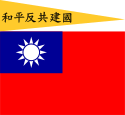Nanjing regime
| Republic of China | ||||||||||||||
|
中華民國 Zhōnghuá Mínguó Chūka Minkoku |
||||||||||||||
| Unrecognized state, puppet regime of the Empire of Japan | ||||||||||||||
|
||||||||||||||
|
Motto 和平反共建國 "Peace, Anti-Communism, National Construction" |
||||||||||||||
|
Anthem National Anthem of the Republic of China |
||||||||||||||
|
Dark green: Republic of China-Nanjing in 1939.
Light green: Mengjiang (incorporated as a region in 1940). |
||||||||||||||
| Capital | Nanjing | |||||||||||||
| Languages |
Chinese Japanese |
|||||||||||||
| Government | Republic | |||||||||||||
| President | ||||||||||||||
| • | 1940–1944 | Wang Jingwei | ||||||||||||
| • | 1944–1945 | Chen Gongbo | ||||||||||||
| Vice President | Zhou Fohai | |||||||||||||
| Historical era | World War II | |||||||||||||
| • | Established | 30 March 1940 | ||||||||||||
| • | Disestablished | 15 August 1945 | ||||||||||||
|
||||||||||||||
| Today part of |
|
|||||||||||||
The Reorganized National Government was the name of the collaborationist government established in the Republic of China from 1940-45.[2] It was led by former Kuomintang (KMT) party member Wang Jingwei.
Wang Jingwei was the leftist leader of a predominantly civilian Kuomintang faction called the Reorganizationists, who were often at odds with Chiang Kai-shek and his military arm of the Kuomintang. Shortly after the Marco Polo Bridge Incident and the initial invasion by the Imperial Japanese Army, Wang Jingwei advocated a strategy of peace and appeasement in order to end the string of devastating losses sustained by the Nationalist Forces and in order to secure the Japanese as a potential ally against the Chinese Communist Party. After the fall of the capital city of Nanjing to the Imperial Japanese Army soon after the start of the Second Sino-Japanese War, the Nationalist government went into exile to Chongqing. On 30 March 1940 Wang Jingwei and his allies defected from Chiang Kai-shek and the Nationalists and established a collaborationist government under the Japanese Army that claimed to be the legitimate representative of all of the Republic of China. This reorganized national government was formed out of a number of previous collaborationist governments that existed in northern and central China, including the Reformed Government of the Republic of China based in eastern China, the Provisional Government of the Republic of China in northern China, and later on the Mengjiang government in Inner Mongolia, though in reality northern China and Inner Mongolia stayed relatively free of its influence. Although using the same state symbols and name of the republic, the new government obtained international recognition only from the Anti-Comintern Pact countries. The exiled Nationalist government in Chongqing continued to be recognized as the legitimate government of China.
...
Wikipedia



